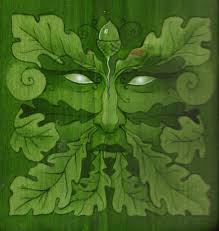
Blessed Beltane everyone! It is that time of year again when we celebrate Beltane, or mayday.
Some of you may have heard of the figure called the green man (Also known as Jack in he green, or the May King). He is commonly seen during Beltane. The Green Man is a god of vegetation and plant life. He symbolizes the life that is found in the natural plant world, and in the earth itself. The Green Man is typically portrayed as a human face surrounded by dense foliage. Such images appear as far back as the eleventh century, in church carvings. As Christianity spread, the Green Man went into hiding, with stonemasons leaving secret images of his face around cathedrals and churches. He enjoyed a revival during the Victorian era, when he became popular with architects, who used his visage as a decorative aspect in buildings. Now that we've discussed a familiar face during Beltane, lets talk about Beltane it's self.
In the old Celtic times, young people would spend the entire night in the woods "A-Maying," and then dance around the phallic Maypole the next morning. Older married couples were allowed to remove their wedding rings (and the restrictions they imply) for this one night. May morning is a magickal time for wild water (dew, flowing streams, and springs) which is collected and used to bathe in for beauty, or to drink for health.
The Christian religion had only a poor substitute for the life-affirming Maypole -- namely, the death-affirming cross. Hence, in the Christian calendar, this was celebrated as 'Roodmas'. In Germany, it was the feast of Saint Walpurga, or 'Walpurgisnacht'. An alternative date around May 5 (Old Beltane), when the sun reaches 15 degrees Taurus, is sometimes employed by Covens. (Both 'Lady Day' and 'Ostara' are names incorrectly assigned to this holiday by some modern traditions of Wicca.)
The May pole was a focal point of the old English village rituals. Many people would rise at the first light of dawn to go outdoors and gather flowers and branches to decorate their homes. Women traditionally would braid flowers into their hair. Men and women alike would decorate their bodies. Beltane marks the return of vitality, of passion. Ancient Pagan traditions say that Beltane marks the emergence of the young God into manhood. Stirred by the energies at work in nature, he desires the Goddess. They fall in love, lie among the grasses and blossoms, and unite. The Goddess becomes pregnant of the God. To celebrate, a wedding feast, for the God and Goddess must be prepared. Let Them guide you! Breads and cereals are popular. Try oatmeal cakes or cookies sweetened with a dab of honey. Dairy foods are again appropriate...just make a lovely wedding feast and you are sure to enjoy yourself! An early morning walk through a local park or forest could be fun for everyone. Gather up some plants or flowers to display in your home. Mom and daughter could braid their hair, and weave in a few tender blossoms.
No comments:
Post a Comment